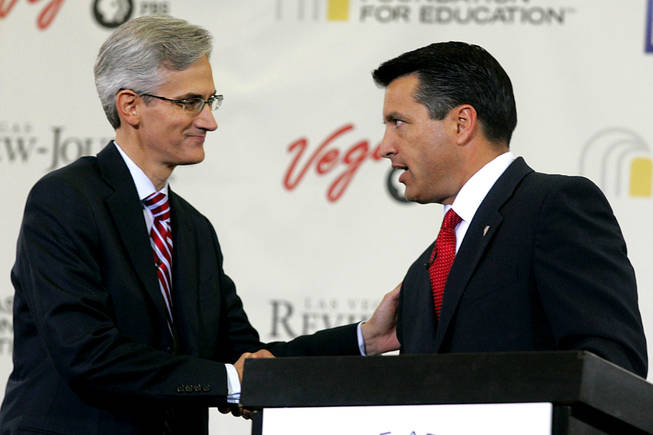
Sam Morris / Las Vegas Sun
Rory Reid and Brian Sandoval shake hands following a debate on education between the gubernatorial candidates Sunday, August 29, 2010.
Tuesday, Aug. 31, 2010 | 2 a.m.
Beyond the Sun
Sun Coverage
Sun Archives
- Beyond the debate, both gubernatorial candidates would cut education (8-30-2010)
- Rory Reid, Brian Sandoval debate on education reforms (8-29-2010)
- Rory Reid’s budget plan for Nevada: All ax, no new tax (8-27-2010)
- Rory Reid’s budget plan: Cut and consolidate but don’t raise taxes (8-26-2010)
- What will voters hear when Rory Reid, Brian Sandoval debate? (8-25-2010)
- What schedules can say about the candidates for governor (8-15-2010)
- No more Mr. Meek: Reid forces Sandoval’s hand with challenge (8-12-2010)
- Rory Reid draws Brian Sandoval into short debate (8-11-2010)
- Sun puts Brian Sandoval, Rory Reid in the hot seat (8-1-2010)
- Candidates for governor answer questions carefully and with few specifics (8-1-2010)
- A comparison of the gubernatorial candidates’ education plans (7-7-2010)
- Brian Sandoval, Rory Reid spar over budget solutions (1-27-2010)
If you’re like most Nevadans, you ignored Sunday’s gubernatorial debate in favor of football or the Emmys. But the candidates soldiered on without you, kicking sand at each other and making claims about their opponent’s positions and their own.
The Las Vegas Sun went back and examined three of the boldest claims made by Republican Brian Sandoval and Democrat Rory Reid. After listening to the banter and circling back with both campaigns, here is what we found:
THE CLAIM:
Reid promised he won’t cut a “penny” from education.
The context
Given that K-12 and higher education make up 55 percent of state general fund spending, Reid is making a bold commitment.
The candidates’ arguments
The 2009 Legislature instituted furloughs for state workers equal to a 4.6 percent pay cut. The state can’t directly control the salaries of teachers — which are governed by union contracts — or tenured faculty, including forcing them to take furloughs. So lawmakers reduced funding for teachers and higher education employees by an equivalent percentage.
Reid proposed last week that one way he will close the $2.5 billion hole is by extending furloughs for state workers, teachers and higher education personnel, saving the state $480 million over two years. Reid argued this plan would keep funding at the levels they are at in the current budget.
During the debate, Sandoval said Reid’s extension of the furloughs was the equivalent of a cut to education funding.
Is the claim accurate?
Reid’s budget proposal would lead to cuts to K-12 and higher education because the furloughs were passed with the expectation that funding would be restored next year. For example, the higher education system, when it passed its budget request last week, called for a $35 million increase for the next two years.
Extending the furloughs would require higher education and school districts to make budget cuts.
Reid’s logic is inconsistent when it involves other parts of the state budget. If extending a cut isn’t really a cut, then extending the approximately $1 billion in taxes scheduled to expire in 2011 would not be a tax increase. Yet both candidates have said they would consider extending those taxes to constitute a tax increase. Both have promised not to do it.
THE CLAIM:
Reid said Sandoval would cut $533 million from education.
The context
In the debate’s lone moment of visual bravado, Reid used a thick black marker to write “$533 m” on a yellow legal pad. He said that’s how much Sandoval’s plan would cut from education, then challenged Sandoval to say what the cut would be if it not that figure.
Sandoval declined, saying, “I’m not going to question your math, Rory. This isn’t a math test, it’s about education.”
The candidates’ arguments
Since Sandoval has refused to reveal how he will balance the state’s budget — and his campaign has refused to hint when he would do it — Reid used his opponent’s short-term deficit plan released in January. Sandoval’s plan was intended to cover an earlier budget deficit.
Here’s Reid’s math:
• $100 million for a voucher program that would give parents money they could use toward private schools.
• $133 million by asking teachers to take a 4 percent pay cut.
• $110 million taken from class-size reduction programs.
• $190 million in additional money taken from teacher salaries.
Sandoval’s campaign disputed the last two points.
The short-term plan released in January did propose taking the $110 million from class-size reductions. But it offset that amount by transferring school construction money from a Clark County School District account.
As for the $190 million, the plan Sandoval released proposed a 4 percent cut to help balance the state’s budget. That, though, was when the budget hole was estimated to be about $500 million. Later forecasts put the budget hole at $800 million. Sandoval’s plan addressed this possibility. “If the budget hole grows beyond ($500 million), salary reductions will need to be greater than those proposed here.”
Reid used that line to extrapolate the additional cuts that Sandoval would seek.
Is the claim accurate?
Basically. Given that Sandoval refuses to release a budget plan, it’s impossible to know how he’s going to handle the state’s budget deficit. Looking at his previous plan, though, does give some sense of how he would approach the state’s current troubles.
Although the cut to the class-size reduction program is offset with school construction money, it would still be a net loss in total funding for education.
And although no one expected the budget gap to grow so large earlier this year, it was Sandoval’s own campaign that said it would backfill any greater budget hole with additional salary cuts.
Until Sandoval can present his plan for the 2011 budget problem, the number will stand.
THE CLAIM:
Reid said Sandoval’s education plan would pull $100 million from public schools to subsidize private education for 4 percent of the state’s children.
The context
Since the primary, Sandoval has been a vocal supporter of school vouchers, a program that has long been championed by conservative Republicans. Beyond saying he supports vouchers, however, Sandoval has said very little about how he would implement them. His nine-page education plan, for example, devotes two lines to vouchers, backed by a citation about how well they work in Milwaukee.
The candidates’ arguments
With the lack of detail coming from the Sandoval campaign, how did the Reid campaign come up with the $100 million to benefit 4 percent of the state’s students?
Assuming the voucher program would be available to anyone who wants to make use of it, it’s logical to start with children currently enrolled in private schools. There are about 20,000 of them. Multiply that by the $5,395 the state spent per pupil last year and you get $108 million.
If every child in private school today was awarded $5,395 for tuition, it would take $100 million away from public schools. Not to mention any increase in students opting for private school under the new program.
Is the claim accurate?
Let’s say this: Sandoval’s spokeswoman Mary-Sarah Kinner didn’t dispute the $100 million figure, but such a program could benefit more than 4 percent of Nevada students.
The campaign refused Monday to provide details about what Sandoval is proposing, saying it will all be “part of a larger discussion” on an eventual voucher program.
Kinner did, however, say the program would be “available to every single Nevada family,” not just the 4 percent of students currently in private schools. If that happens, vouchers will cost the state more than $100 million.
“All parents will be given ultimate flexibility with the tax dollars set aside for the education of their children,” she said in a written statement.


Join the Discussion:
Check this out for a full explanation of our conversion to the LiveFyre commenting system and instructions on how to sign up for an account.
Full comments policy